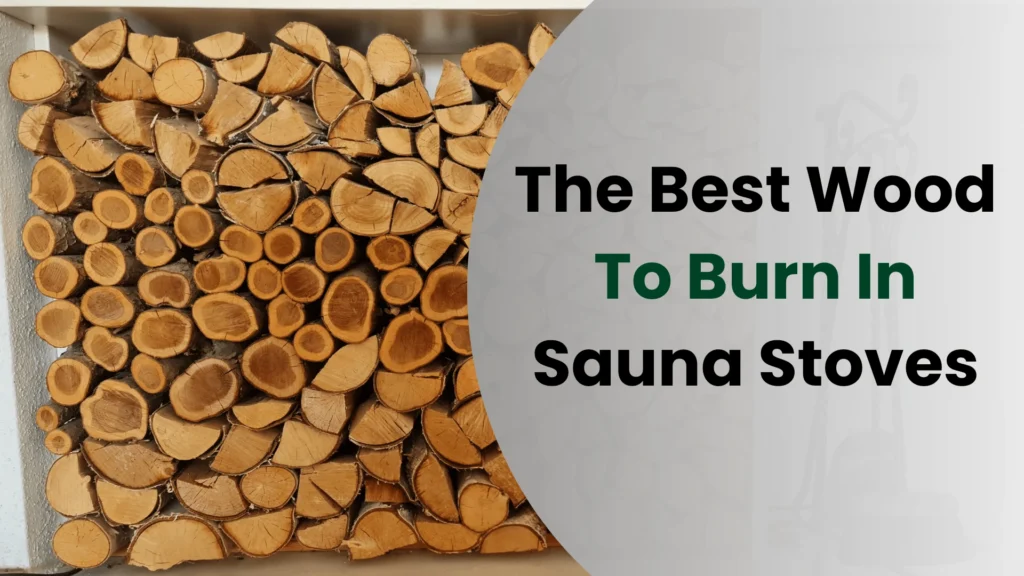Choosing the best logs to burn in your sauna stove will greatly impact the performance and efficiency of your sauna.
Not all wood types are equally good. And some should be avoided completely!
We’re here to help you choose the best wood to burn in your sauna stove.
Selecting wood for your sauna stove involves considering specific qualities to enhance your sauna experience.
This article will explain what logs you should (and should not) burn in your sauna stove and what wood qualities to consider.
Let’s get right into it!
Table of Contents
Why Does The Wood You Burn In Your Sauna Stove Matter?
Different wood types have different qualities that affect their burning time, heat output, and efficiency.
Knowing the pros and cons of different wood types is essential in making the best choice.
Choosing the best wood for your wood burning stove is crucial for the longevity and performance of your sauna.
It ensures efficient heating of your sauna and improves the overall durability and functionality of your stove.
Opting for the right wood reduces creosote buildup, minimizes harmful emissions, and protects your stove from moisture damage.
Hardwoods VS Softwoods
Hardwoods such as ash, birch, oak, and beech are better to burn in your sauna stove than softwoods.
Hardwoods have a higher heat output and a lower resin content. This improves the efficiency of your stove and minimizes creosote buildup.
One problem you might run into when using hardwood logs is that they are difficult to set on fire.
An easy way to go about it is to use softwood as kindling. Softwood burns quickly and efficiently and is great for starting fires.
(Cedar is a softwood that works great as a kindling. It produces a pleasant aroma and burns very effectively)
Wood Qualities To Consider
Here are the most important qualities to remember when choosing the best wood for burning in your sauna heater.
Heat Output
The heat output of the wood used in your sauna stove determines the overall effectiveness and comfort of your sauna experience.
Hardwoods like birch, ash, and oak have a higher heat output than softwoods like pine, fir, and cedar.
Higher heat output ensures your sauna reaches and maintains the ideal temperature faster.
Moisture Content
Choose wood with a low moisture content. Wet logs are difficult to ignite and produce a lot of smoke.
Logs with low moisture content are easy to ignite, highly efficient, and produce less smoke.
The moisture content should be below 20%.
Wood with minimal moisture content also has a higher heat output efficiency.
When the energy isn’t used to evaporate water from the wood, it goes towards heating your sauna.
Not only does this contribute to a quicker warm-up time, but it also improves the overall performance of your sauna stove.
Resin Content
Firstly, low resin content contributes to a cleaner and safer burning process.
Resin produces more smoke and releases aromatic compounds when burned. This can be problematic in the confined space of a sauna.
Choosing wood with low resin content helps minimize smoke production.
Less smoke production creates a more pleasant and healthier environment in your sauna.
Secondly, low resin content reduces the risk of creosote buildup in your sauna chimney.
Creosote is a byproduct of incomplete combustion. Creosote buildup in your chimney can pose a fire hazard and cause health issues.
Lastly, low resin content contributes to a more even and controllable burn.
Resin-rich wood can create fluctuations in the flame and affect the sauna temperature.
Burning Seasoned VS Unseasoned Wood
We always recommend that you season your wood before burning it.
“Seasoning” your wood means that your firewood has been allowed to dry for some time. Different wood species have different seasoning times. Check the chart below to see the seasoning time for different wood species.
Seasoned wood (or dry wood) has a moisture content below 20%.
The benefits of seasoning your wood is that it produces less smoke and minimizes creosote build-up.
You can season both hardwood and softwood. Seasoning softwood makes it a lot safer to use. It will produce less smoke and cause very little creosote build-up.
But seasoned hardwood is still a better option than seasoned softwood for burning in your sauna stove.
Why Hardwood Is The Best Wood To Burn
Plain and simple, hardwoods such as ash, oak, birch, beech, apple, and hickory are the best woods to burn in your sauna stove.
But why?
Hardwoods have some qualities that make them optimal for burning.
Firstly, heat output.
Hardwoods burn slowly and have excellent heat output. This is simply due to their high density.
These wood types ensure a steady and intense burn for the perfect sauna temperature.
Secondly. Low resin content.
Hardwoods have a low resin content.
As I mentioned, woods with a low resin content produce less smoke and minimize the risk of creosote buildup in your chimney.
All in all, hardwoods are great for burning in your sauna stove. But make sure that the moisture content is less than 20%.
I recommend that you opt for kiln-dried (oven-dried) or seasoned (air-dried) hardwood since they will have a low moisture content.
Ash
Ash is generally considered to be the best firewood. Ash burns slowly with a high heat output. It has a naturally low moisture content and produces very little smoke.
Ash can even be burned “green” (without seasoning) thanks to its low moisture content (but it’s best when seasoned). Ash needs to be seasoned for 12 months.
Oak
Oak is a slow-burning hardwood with a high heat output. It creates low amounts of smoke. The drawback is that oak needs to be seasoned for a long time (about 36 months).
Birch
Birch is a “softer” hardwood. It ignites easily, burns fairly quickly, and has a high heat output. It works great as both kindling and primary firewood. Birch bark is an excellent fire starter.
Birch needs to be seasoned for about 18-24 months. It burns clean and produces low amounts of smoke when properly seasoned.
Beech
Beech wood burns long and hot. Green beech wood has a high moisture content and needs to be seasoned for 1-2 years. After proper seasoning, it creates very little smoke.
Apple
Apple has a high heat output and burns for a long time. It produces a pleasant smell with low smoke. Apple needs to be seasoned for 24 months (2 years) for optimal performance.
Hickory
Hickory is one of the hardest readily available woods in the United States. It burns slowly and hot thanks to its high density.
Hickory needs to be seasoned for 24 months. Once hickory is fully seasoned it creates almost no smoke at all!
Chart Of The Best Firewoods
| Wood Species | Hard/Soft | Seasoning (months) | Smoke Production | Burning Time | Heat Production | Suitability To Burn |
| Alder | Soft | 18 | Low/Medium | Short | Low | Bad |
| Apple | Hard | 24 | Low | Long | High | Great |
| Ash | Hard | 12 | Low | Long | Very High | Excellent |
| Aspen | Hard | 12 | Low | Medium | Medium | OK |
| Beech | Hard | 12-24 | Low | Long | High | Great |
| Birch | Hard | 18-24 | Low/Medium | Medium | High | Great |
| Cedar | Soft | 6 | Medium | Medium | Low | OK |
| Cherry | Hard | 12 | Medium | Medium | Good | Good |
| Douglas Fir | Soft | 12 | Medium | Short | Medium | Bad |
| Elm | Hard | 18 | Medium | Medium | Medium | OK |
| Hemlock | Soft | 12 | Medium | Medium | Medium | OK |
| Hickory | Hard | 24 | Low | Long | High | Great |
| Maple | Hard | 12 | Low | Medium | High | Good |
| Oak | Hard | 36 | Low | Long | Very High | Excellent |
| Pine | Soft | 6 | High | Short | Medium | Bad |
| Spruce | Soft | 12 | Medium | Short | Low | Bad |
| Walnut | Hard | 12 | Low/Medium | Medium | High | Good |
How To Feed Your Sauna Stove
Here is my step-by-step guide on how to feed your stove and heat your sauna quickly.
Things You Need:
Dry Kindling
The best kindling for sauna stoves is softwoods, especially cedar and hickory. Birch bark is another great option since it lights quickly and burns intensely.
Your kindling wood should be short and thin. About 6-8 inches (15-20 cm) long and 0.5-1.5 inches (2-4 cm) in diameter.
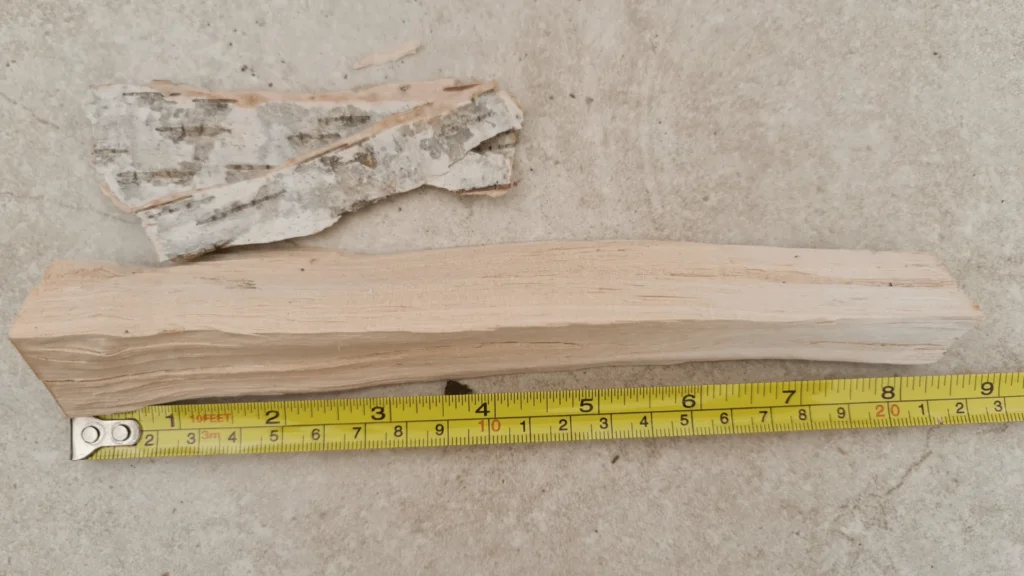
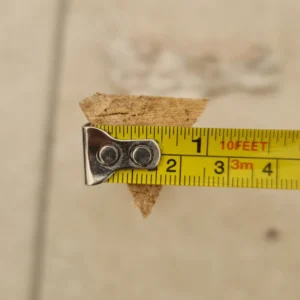
Dry Fire Logs
Hardwoods like birch, ash, and oak are the best woods to burn in your sauna stove. Opt for kiln-dried or seasoned firelogs.
Your fire logs should be about 8-12 inches (20-30 cm) long and 3-5 inches (8-12 cm) in diameter. (It also largely depends on the size of your sauna stove)
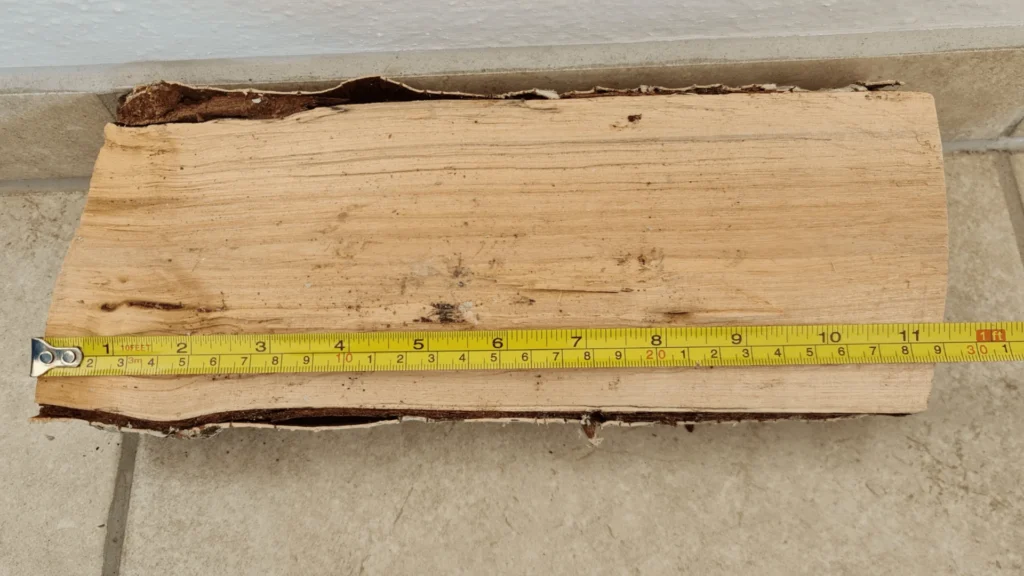
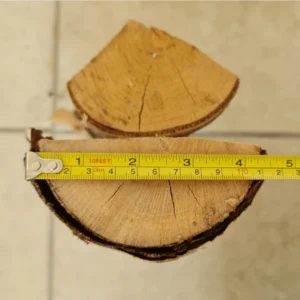
Matches Or Lighter
How you light the fire is up to you. I like to use long-burning matches since it allows me to start the fire in multiple places.
Step-By-Step Guide:
Step 1
Always ensure your furnace dampers are open before starting a fire in your sauna stove!
Step 2
Empty the ash box. If the ash box is full it’ll disrupt the airflow into the furnace and make it harder to start the fire.
Step 3
Start by building a base of hardwoods. This will be the foundation that the softwood and birch bark lays on top of.
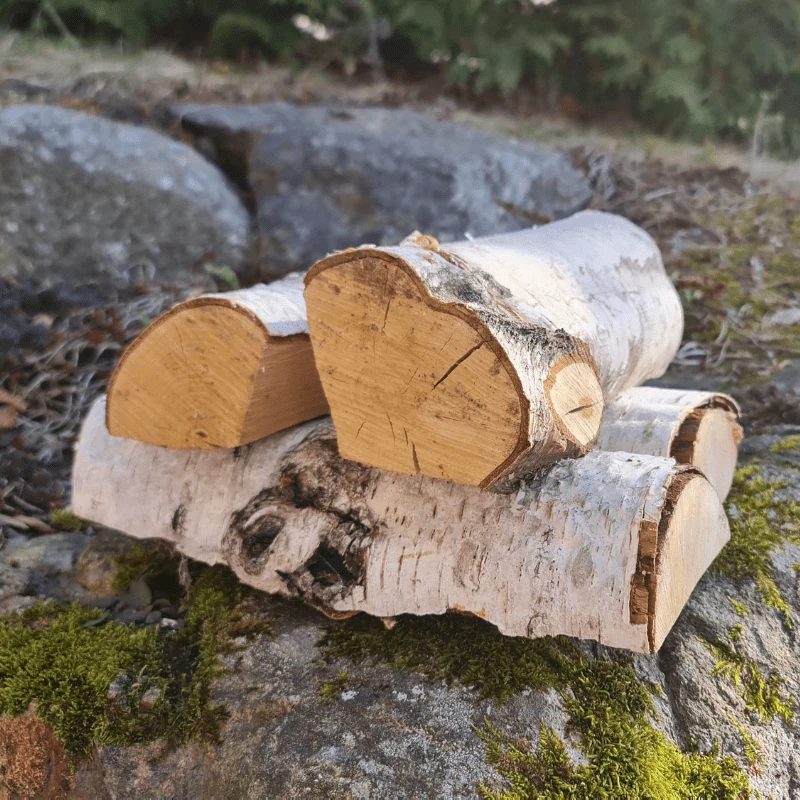
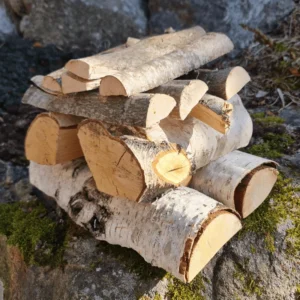
(Optional) Place the slowest burning hardwoods at the bottom (like ash and oak), and some faster igniting hardwoods (like birch) on top.
Step 3.5
Build the top layer of softwood kindling and some birch bark tucked in between the softwood.
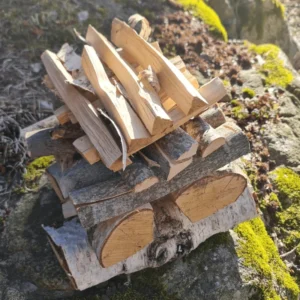
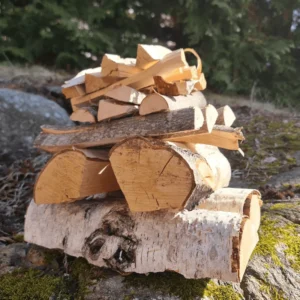
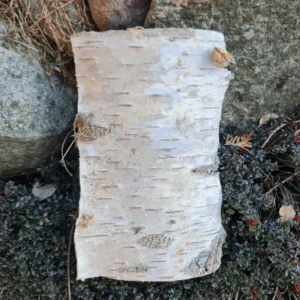
The benefit of starting the fire on the top of the firewood is that it produces fewer emissions.
Step 4
Open the ash box slightly to improve the airflow. Light the birch bark in multiple places. The fire will spread to the kindling and hardwood. You’ll have a good fire going in no time!
The furnace should be filled but not cramped. There needs to be enough space for proper airflow.
Step 5
Close the furnace door as soon as you lit the fire. You can keep the ash box ajar to ensure the fire gets fuelled with air.
You can close the ash box once the sauna reaches your desired temperature. This will keep down the fire and decrease wood consumption.
Step 6
You can add more hardwood logs if the fire starts to burn out. Ash and oak are excellent choices as they burn very hot and slowly.
I always use this method to light my sauna. It works like a charm. It takes about 15 minutes to get a good fire going, and the sauna heats up in about 20 minutes.
What To NOT Burn In Your Sauna Stove
Here are some items that you shouldn’t burn in your sauna stove. Burning them poses fire hazards and causes health issues.
Materials With A High Thermal Value
You should avoid burning materials such as chipboard, plastic, coal, briquettes, and pellets.
These materials have a high thermal value. This means they have high heat transfer and burn at a very high temperature.
It might seem like a good idea to burn materials that provide more heat. But this can shorten the lifespan of your sauna stove.
Painted Or Impregnated Wood
Painted and impregnated wood releases toxic fumes when they burn. You definitely don’t want these fumes to circulate in your sauna!
General Waste
Household waste such as PVC plastic, textiles, leather, rubber, and disposable diapers also releases toxic fumes.
Garden Waste
Plants and trees absorb water and minerals from the ground which are stored in the leaves.
The water can be contaminated with pesticides and fertilizers that create harmful gasses when they burn.
Liquid Fuel (Super Dangerous!)
Avoid using liquid fuels, charcoal lighter fluid, and other fire accelerants as they present a fire hazard.
Liquid fuels and accelerants are designed for outside use only! If you use them inside a sealed sauna stove, the liquid evaporates faster than it can combust.
When the fuel evaporates, it spreads throughout the sauna before eventually catching on fire.
And KABOOM! You just created a bomb.
How To Store Your Firewood
Storing your firewood correctly makes life much easier when you have to fire up your sauna.
Store In A Dry Place
Keep your firewood dry to improve its efficiency and minimize smoke production. Store it inside if possible, or under a waterproof tarp.
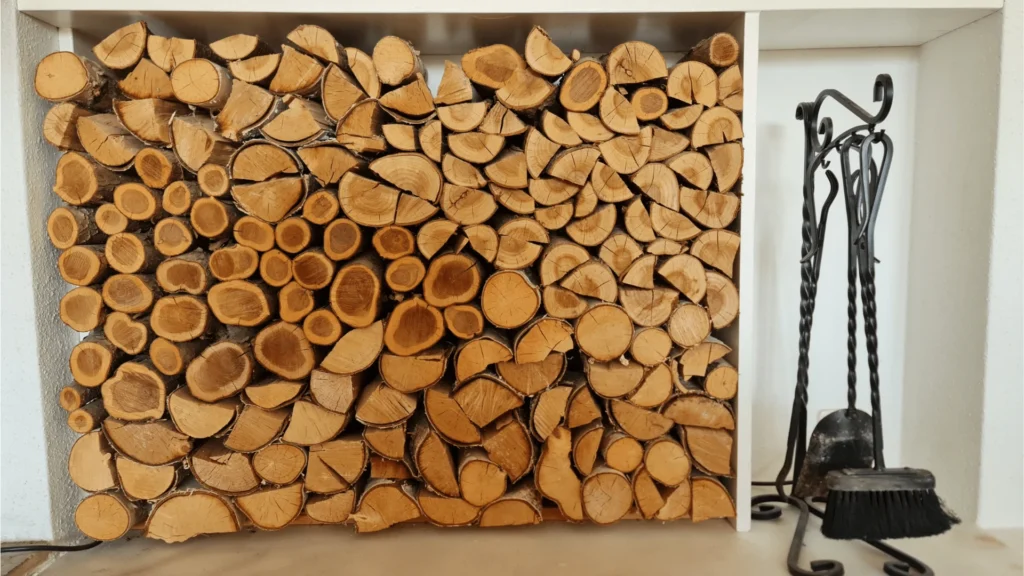
Elevate Your Logs
Keep some distance between the firewood and the wet ground (you can elevate them using a wooden pallet).
Use A Waterproof Tarp
Place a waterproof tarp over your firewood if you store it outside. Leave some room for airflow and circulation.
FAQs – Best Firewood For Saunas
Here are the answers to some frequently asked questions about firewood and wood burning saunas.
What Are The Most Efficient Logs To Burn?
The most efficient logs to burn are hardwood logs. Ash is regarded as the most efficient choice, but other hardwoods like oak, birch, and beech are also great.
Avoid using woods with a high resin content. Avoid softwoods unless you use them as kindling.
A good guideline is that heavier woods have a higher heat output and a longer burn time.
What Logs Give The Best Heat?
Ash is known for burning the hottest, even if the wood isn’t completely dry.
Beech is another excellent option for sauna stoves. It has a high heat output but requires seasoning to perform at its best.
Hardwoods like oak, ash, birch, and beech have better heat output than other hardwoods such as walnut and elm.
It’s worth noting that all hardwoods (including those with slightly lower heat values) still perform better than softwoods like pine and cedar when it comes to heat production.
Which Firewood Burns The Longest?
Hardwoods such as ash, oak, beech, and fruit trees like apple or cherry burn the longest.
Hardwoods are denser and offer a longer-lasting and hotter burn compared to softwoods. Allow the wood to season before burning it.
This ensures that you get the best performance possible.
What Are The Cleanest Burning Fire Logs?
Seasoned hardwoods such as ash and oak are the most efficient and cleanest logs to burn.
They create very little smoke and have a low resin content.
Seasoning your firewood decreases the moisture content and results in a cleaner burning process.
It’s important to season both your hardwood and softwood.
What Wood Should You Avoid Burning?
Avoid burning rotten and moldy wood. They are spongy and produce very little heat.
Rotten and moldy wood tends to have a higher water content making it harder to light and produce more smoke.
Burning moldy wood can also produce toxic fumes that can cause irritation.
Also, be careful with woods with “poison” in the name. Some examples are poison ivy and poison oak. They contain irritants that are released into the smoke.
Inhaling the smoke can cause lung irritation and respiratory problems.
Other woods to avoid are;
Willow: Burns cool and generates excessive smoke.
Alder: Requires lots of effort with minimal results. They burn fast with a low heat output.
Chestnut: Has a weak flame, a low heat output, and produces lots of smoke.
Is It Better To Burn Large Or Small Logs?
Burning large logs can be challenging, and the drying process is longer.
Smaller and thinner logs are easier to burn and require less time to dry.
Always split your firewood into smaller pieces. It helps the innermost core to dry.
It also allows you to fit them more easily in your sauna stove.
Is It OK To Burn Plywood In A Sauna Stove?
Plywood is a common material in construction and furniture making, but it’s not suitable as fuel for wood-burning sauna stoves.
Plywood is bonded with synthetic resins. Burning it can release harmful chemicals into the air.
Why Is My Wood Burning Sauna Not Hot Enough?
Here are some tips to get your sauna to the required temperature:
Use small chopped wood. Start your fire with softwood and fuel it with hardwoods that burn hotter and longer.
Ensure the stove is well-ventilated and gets sufficient airflow. It’s also important that your sauna is properly insulated.
Make sure that the wood is dry and well-seasoned. Wet wood burns cold and inefficiently.
Your sauna stove might also be too big or too small for your sauna.
Your sauna stove output must be appropriate for your sauna size.
Do You Need A Special Wood Stove For Saunas?
I don’t recommend you use a regular house stove in your sauna. Saunas require a sauna stove explicitly designed for the purpose.
Regular wood stoves don’t provide the optimal heat performance intended for saunas.
Choosing a dedicated sauna stove ensures safety and maximizes the heating efficiency of your sauna.

